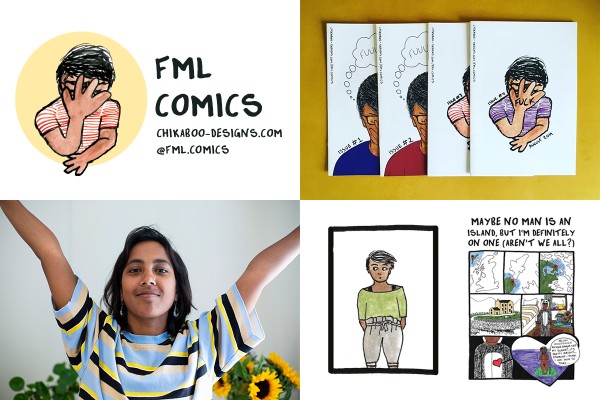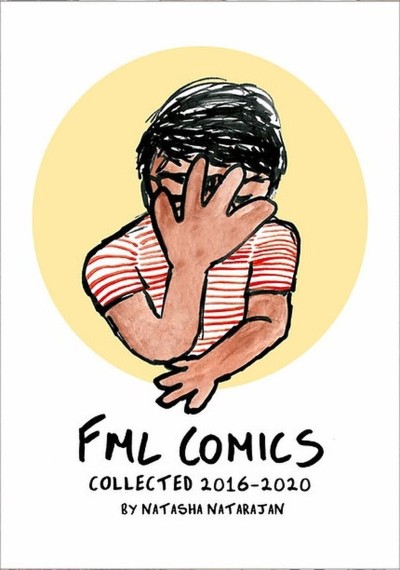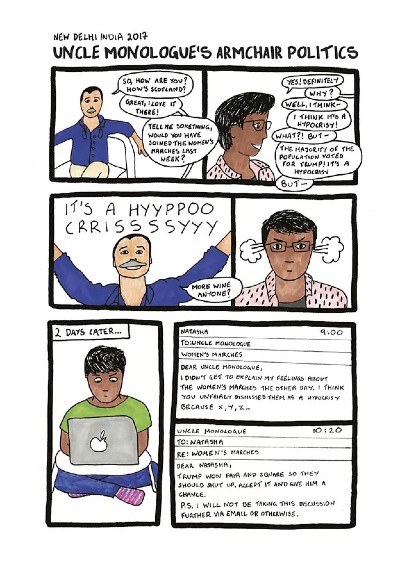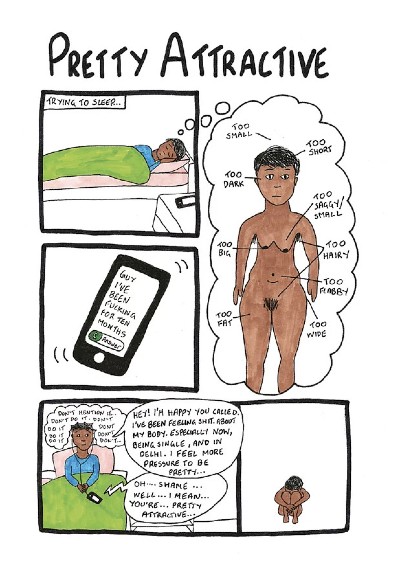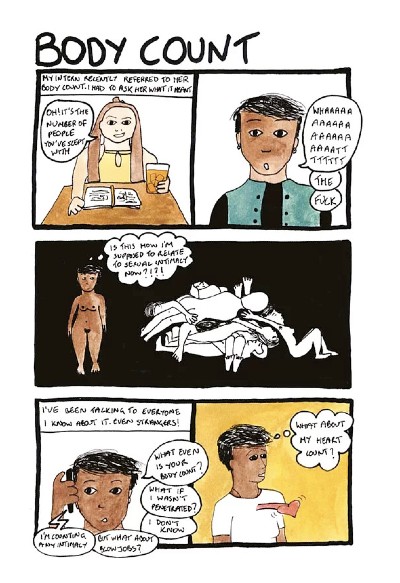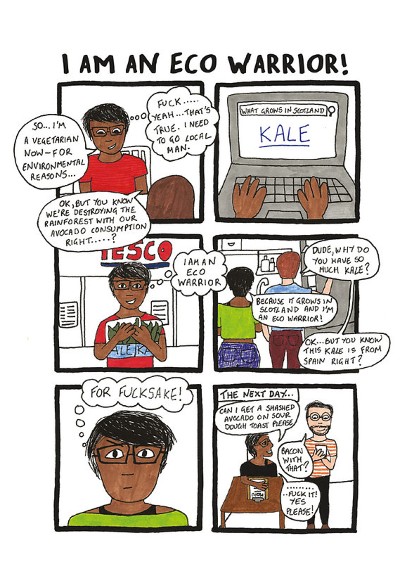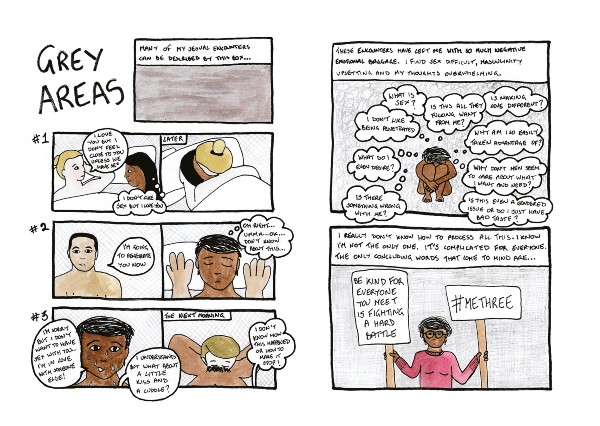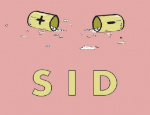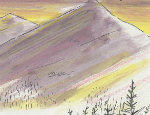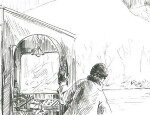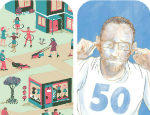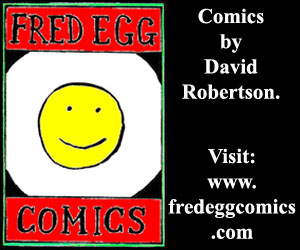Natasha Natarajan’s book FML Comics Collected 2016-2020 was part of Good Comics‘ Kickstarted bundle of books last year and compiles her autobiographical comic strips from 2016-2020. Evolving intuitively and ranging from simple anecdotes to deep reflections on life, this body of work charts the author’s adventures, sexploits, mental health troubles and personal growth with relatable honesty and laugh out loud moments. Jenny Robins caught up with her to ask way too many questions.
BROKEN FRONTIER: Do you think it is actually possible to fail a life? Wait, is it Fail My Life, or Fuck My Life?
NATASHA NATARAJAN: Haha! I never even thought of Fail My Life as a possible title. It’s amazing how your work totally takes on a life of its own after you’ve put it into the world. My comic strip started as ‘Fuck My Life’ spelt out as I mentioned before. And I intended it to be about those facepalm kind of moments. But it has obviously evolved since then and is about a lot of different things. In 2019 I changed it to ‘FML’ so it wasn’t so sweary and better in search results and Mailchimp newsletters. But symbolically I also like that you can make your own title. Sometimes I think of it as ‘For My Life’ comics or ‘From My Life.’ I’m happy for the reader to decide what the title is.
To answer your actual question, in my heart of hearts, no I don’t think you can fail a life. But I definitely have an inner voice that sees success in really conventional ways, and I judge myself and others according to it all the time in my every day. I am still working on silencing that voice.
FML Comics Collected 2016-2020 is the first published book of my autobiographical comic strip FML Comics. I describe it as “an opportunity to be inside the mind of a 20-something British-Indian woman navigating the 21st century.” The FML stands for ‘Fuck My Life’ because it began as a humorous comic documenting my embarrassing/cringe experiences.
Actually, when I first starting writing my comics I even called it Fuck My Life Comics completely spelled out. I only changed it to FML in 2019 – partly because I didn’t want to have “Fuck” in the title anymore and partly because over the years the angst has diminished, and I wanted the title to be more ambiguous.
BF: How did this project start and what was its journey to becoming a print book?
NATARAJAN: It started with a doodle on a bit of paper really. I was obsessively over-analysing an embarrassing drunk moment I had shared with this guy (see comic Cool Sound Engineer Guy) and I started drawing it on bits of paper. I wasn’t an artist, I hardly drew, I was really just messing around. But I liked how the doodles looked and I thought it was funny so I tried drawing other awkward moments I had experienced. It sort of just evolved from there. The journey to becoming a book seems quite long in my head and involves lots of random encounters and networking. But I think probably the most important part of my journey has been self-publishing in the zine community. I printed 4 issues of my comic into A5 zines before making it into one book and submitting it to my publisher, Good Comics. I don’t think I would have made it this far without zine fairs, zine makers and zine enthusiasts.
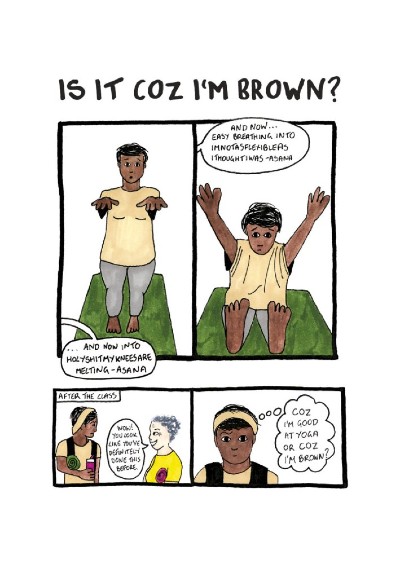 BF: You are part of what has become a grand tradition of female autobio comic makers in the UK scene. Do you think there is something that makes women and marginalised genderfolk more likely to write and draw their own stories than other people’s?
BF: You are part of what has become a grand tradition of female autobio comic makers in the UK scene. Do you think there is something that makes women and marginalised genderfolk more likely to write and draw their own stories than other people’s?
NATARAJAN: That is such a good question. I don’t actually have a good answer to it but I want you to put it in this interview because I find it really interesting. Off the top of my head I feel like it might have something to do with levels of self-awareness.
BF: I love the way you explicitly name your characters – from descriptive and non personal love interests like Cool Sound Engineer Guy, to the pet names you and your friends call each other. How did you choose who to name and how?
NATARAJAN: Thank you for asking this question. I love it and I’m really happy you noticed. When I first started making comics, half the fun was naming the characters which was actually also titling the comics. To this day, I think the title of the comic is half the story. It’s what ties the comic together – gives it the message, or delivers the punchline. So the name of the character is often a big part of the joke. I mean I’m definitely making fun of myself in my comics, but I am also satirising people I encounter – Cool Sound Engineer Guy, Hot Genius Guy, Living in the Moment Guy, The Perfect Butch.
It wasn’t hard to come up with the names. For a big part of my 20s, my love life was a running joke amongst friends. We already had a lot of in-jokes about people. I LOVE in-jokes, catchphrases and all that. In general, I love a good giggle.
All the pet names are also real – Ernie, Ayeshles, Boo. I like pet names because they’re a symbol of intimacy or a special bond. I have pet names for all my close friends. To be honest, sometimes when I am making a comic about a friend, it’s really an in-joke for us to enjoy together.
BF: Transforming a body of work amassed over 4 years and several life changes into a single book must have been daunting, what approaches helped? The explanations that link each section of the book must have been added during the later stages, so how did you choose what information to include to create the right balance of context and mystery?
NATARAJAN: It didn’t feel daunting, the idea of making a comic book and having a publisher was really exciting and fun. There has never been any financial purpose for me which really takes the pressure off and the content was already made! I started the process of putting it all together when lockdown hit us in March. I printed all my comic strips black and white onto A6 bits of paper and stuck them on my wall. I wanted to see if I could organise them thematically. But in the end I found that a lot of comics had multiple themes and it flowed best in the order that they were made. I decided to have written sections because I wanted to offer something more to my long-term fans who had already purchased all my zines.
Once I had ordered chronologically, the sections came to me pretty easily. Maybe because I have thought a lot about the past 5 years, both in therapy and in general. It was easy to demarcate the sections because I had moved around a lot and many life changing things had happened. I didn’t really think about the balance of context and mystery. I just knew that I didn’t want the written parts to be too long. It happened quite naturally that I couldn’t explain everything.
In terms of approach – I have a habit of just starting things. I don’t think too much, I just start. That really works for me and that’s what I did with the book. Quite early in the process I also got mentoring from LDComics and I asked 5 friends to give me feedback, that helped give me the confidence to know I was headed in the right direction.
BF: Were there many autobio comics you made in those years that didn’t make it to the book? How did you choose what to keep in and what to leave out?
NATARAJAN: There are a number of comics that are in Issue #1 to #4 of my zine that didn’t make it into the final book. There was a bit of back and forth with my publisher about which ones to leave out. There are some where I don’t like the drawing, some which don’t have much of a message or purpose, some where the joke didn’t land that well. I guess those are the main reasons I left comics out.
BF: Baring your soul (and your private parts) in print must lead to some interesting dynamics when strangers know some of your most intimate thoughts – how has that played out? Has it been interesting? Has it ever made you regret revealing so much?
NATARAJAN: I don’t think I’ve ever regretted it. Not even the nudity bothers me that much. Perhaps because it’s in cartoon form. I actually feel quite relieved that people I meet know what I really think and feel without me having to explain. And that they still want to know me and talk to me. I also really like that it enables people to spark conversations with me about topics they know I am interested in. It also enables them to be vulnerable around me and talk about painful things.
There is a certain amount of hiding I do – like with older or more conservative people, maybe some relatives. I might not mention that I make comics or I will purposefully not share details about where to find them. The only person who I know has read it and feels uncomfortable about parts is my mum. I used to hide my comics from her. I think she knew why and accepted that. There was a kind of mutual understanding. But when the book was being published, she was really excited for me and I think she wanted to be able to share in the success. I was so nervous about her reading it. I told her a billion times that there was a lot of uncomfortable content in it. I suggested she read it back to front because it would be more digestible. Anyway in the end she read it in it’s entirety and actually said some really nice things. We didn’t talk in any detail about the content but I feel really relieved that she knows those parts of me and still loves me. I was carrying a lot shame and this feeling of living two lives… Now she’s semi-hiding it from my dad and extended family. But I’m ok with that. I get it.
BF: At what point did you stop ending all these comics with a swear word? Was it a conscious choice? Do you think that reflects a change in your view of life?
NATARAJAN: It wasn’t a conscious choice. I just got really into making comics and I was exploring different themes. It didn’t always fit the story to end with a swear word. I guess I was becoming a better storyteller as well. But also I think you’re totally right. It definitely reflects a change in my view of life. Especially while I was suffering with mental health issues, I stopped seeing my life as one big joke or punchline. My comics became really different during that time – I was often the only character, there were A LOT more thought bubbles, less speech bubbles and lots of metaphorical internal conversations. I think my comics really evolve with me.
BF: Do you find making comics about serious issues helps you to process them? Same question, but about funny embarrassing incidents?
NATARAJAN: Definitely. 100%. My comics are a therapy for me. First and foremost I write them for myself to process things that are bothering me. The process of writing the story, finding the cause and effect of issues, discovering which parts of the story are important to include, how I want to draw myself and depict the emotions. It’s a very rewarding process and there’s something so satisfying about seeing cartoon Natasha go through it all.
BF: Right at the centre of the book is a story about a deeply insensitive racial comment and how that made you feel. Was this a conscious choice? Do you see it as the heart of the book or a turning point in some way?
NATARAJAN: Wow I didn’t know that it was at the centre of the book! I think the universe is speaking to me. I don’t see it as the heart of the book. Unfortunately, I have to admit that it wasn’t even a turning point for that relationship – maybe in some ways, but not concretely. So again it’s interesting to see how the reader understands the book. Perhaps there are things that I can’t see yet, that the reader can. I’m not sure.
BF: There is a lot of darkness and angst in the book, but also a lot of strength and humour. Did you consciously balance the two, both in the original comics and editing the book, or is that just who you are?
NATARAJAN: Thank you, that’s really kind of you to say. There have been moments of conscious reflection. At the peak of my mental health issues a stranger reached out to console me on Instagram after a comic I’d written (I actually made that experience into a meta comic called A Cry for Help). After that I did worry that my comics were becoming too depressing and in the back of my mind I tried to rectify that. I have also worried at times that my comics were too focused on my male lovers and I didn’t have enough strips that passed the Bechdel Test (also made a meta comic about that The Bechdel Test). So there have been moments where I have tried to maintain some kind of balance be it in theme or content. I think I recognise that my comics are a reflection of myself and my inner life, so when I see imbalance it’s an opportunity to look in the mirror.
In terms of the book, that wasn’t an issue though. I think the balance was already maintained in the making of the originals.
BF: What is your process, in terms of art materials and software used?
NATARAJAN: My comics are made manually on paper before scanning them and digitising them with photoshop. I actually made some tutorial videos about my digital process and the manual process is quite well documented in this video.
But to be honest, I‘m not very consistent or particular about my materials. Partly, because I’ve been travelling around the past 5 years and partly because I can be quite cheap! Luckily the aesthetic is quite forgiving.
I use pretty much any white art paper although given the opportunity I will buy Bristol Board. Before I start drawing I draft a script and the panels on scrap paper. Then I pencil them on the final A5 sheet of paper I am going to use. There’s a lot of erasing that happens when I am drawing. I use Sakura or Staedler fine liners (mostly 0.05, 0.2, 0.3 and 0.5) to ink the work. The borders and titles are drawn with a thick permanent marker or Sharpie. Then I erase the pencil marks and colour the comic with watercolours. Originally I used ink pens for colouring but they are very expensive and I like making comics while I travel or in coffee shops so it’s much easier to carry around a small watercolour set. Fun fact – I have been using the same Windsor & Newton mini watercolour set since 2017 to make ALL my comics. Anyway then I scan and digitise. I brighten the colours, erase any mistakes and all that on Photoshop.
BF: Can you talk about what was special about the zine community in Edinburgh, and how that may have shaped this work?
NATARAJAN: It was just so motivating and exciting to have an outlet for this thing I had begun making. The zine community had people I could show my comics to, people who bought them and also a lot of people exploring similar topics and themes. I felt so validated by all of that. Zine fairs and events were also such a fun way to spend time. And they revealed this whole world of underground creativity to me. I also really loved the spirit of zines (though I have to admit I feel it’s changed over the past few years). At least in those days it was very small, democratic, uncommercial and DIY. It really aligned with my politics and life philosophy. I also networked a lot and made a lot of creative connections. Without zines, I don’t think I would have made so many comics or pursued a career in the arts. I wouldn’t have had confidence in my skills.
I suppose even without zines I might have joined Instagram eventually and built up an audience that way. But I think the zine community taught me to really value and enjoy small, in-person, social DIY creativity. Something that Instagram could never have shown me. And I think that spirit is a core part of FML Comics for me.
BF: Can you talk about what was special about studying art in the middle of nowhere (University of the Highlands and Islands) and how that may have shaped this work?
NATARAJAN: Doing art school anywhere else would have really intimidated me. In the outer Hebrides I enjoyed a lot of space and solitude. That really helped me explore my creativity. And I felt a really strong bond with the small community of artists that I studied and worked with there. It was contained in all the right ways and expansive in all the right ways. I think my experience there gave me a lot of confidence in my creativity. I think that really helped the development of FML Comics.
BF: Your feelings about sex and love certainly seemed to evolve during the course of these years of comic-making, or do you think you just got better at understanding those feelings?
NATARAJAN: When it comes to sex and love, everything has most definitely completely earth-shatteringly changed in my life. That is definitely reflected in the comics. It was a whole journey that I’m glad comes across in the book. I hope it benefits someone! It was both an evolution and a process of understanding my feelings and myself better.
BF: What are you working on next/now?
NATARAJAN: At the moment I am the School Illustrator in Residence for House of Illustration which basically means I’m trying to make comics with 7-year-olds! I also run a weekly art club (online at the moment) with primary school children. I am getting ready for an exhibition at The Cartoon Museum this summer and I have been working on a comic strip featuring two dogs – Belly & Schmatu.
BF: What role do you think comics have in the evolving political and social landscape (hellscape?) moving forward?
NATARAJAN: I am not sure about the industry or art form as a whole. But I personally find my comics a really useful way of starting conversations around social and political issues amongst friends and family. I am also starting to see the power of comics in educational and therapeutic settings. They can be a less intimidating way of story telling and expressing yourself. In general I feel really proud to be part of the comics community and I feel constantly inspired by the people in our community. Such a varied, intelligent bunch!
You can order FML Comics here and see more of Natasha’s work here.
Follow Natasha on Instagram here. You can also visit the Good Comics site/store here.
Interview by Jenny Robins





